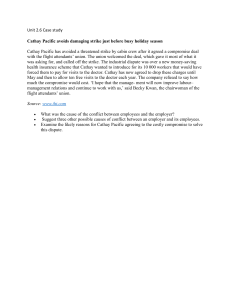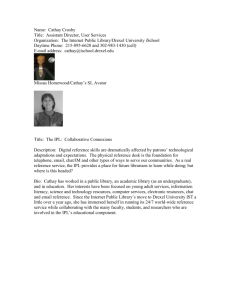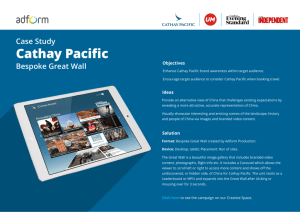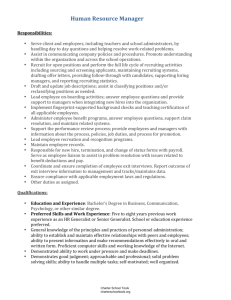L5G2-project
advertisement
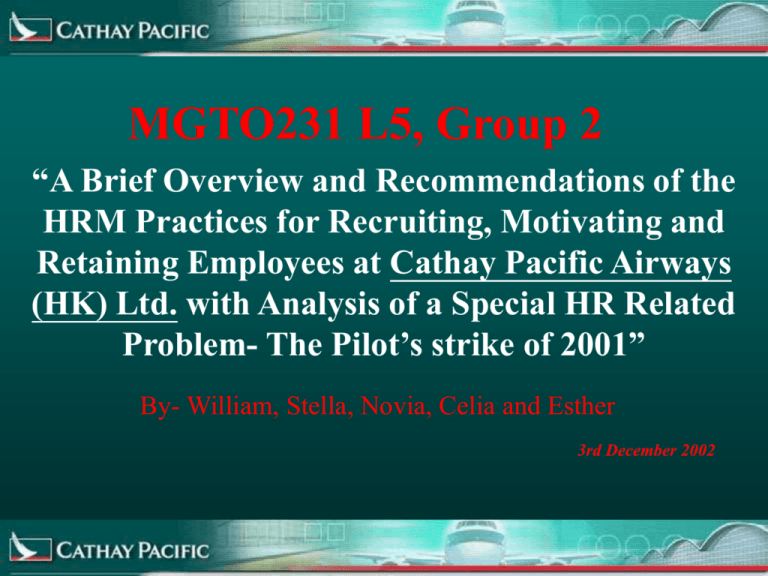
MGTO231 L5, Group 2 “A Brief Overview and Recommendations of the HRM Practices for Recruiting, Motivating and Retaining Employees at Cathay Pacific Airways (HK) Ltd. with Analysis of a Special HR Related Problem- The Pilot’s strike of 2001” By- William, Stella, Novia, Celia and Esther 3rd December 2002 Presentation Objectives At the End of the Presentation, We Hope That You Will: •Know more about Cathay Pacific, In Particular: •Know more about the general HRM practices employed at Cathay Pacific to Retain, Motivate and Attract Employees, and how the company dealt with the Pilot’s Strike of 2001 •Hope that the presentation will be so informative and entertaining that it will entice you to apply for work at the airline! Introduction to the Airline •Established in 1946, in Shanghai, China as a cargo operator running between Shanghai and Sydney, Australia. •Moved to Hong Kong in 1949 after rejecting two buyout offers, and established itself as a passenger carrier after the population in Hong Kong increased threefold. •Today, Cathay Pacific serves 58 destinations worldwide, and is one of the most reputed airlines in the world, with interim profits this year at HK$1,412m •Employs over 14,000 staff- approximately 5,000 ground-staff, 5,000 flight attendants, 1,000 pilots and 3,000 employees at overseas branches. Corporate Values Corporate Culture and Values: Mission : •“To Provide Service Straight from the Heart” •“To be the Most Admired Airline in the World” •To Ensure that Safety Comes First •To Encourage Product Leadership •To Provide Rewarding Career Opportunities •To Deliver Superior Financial Returns Methodology: Sources That we Gathered Information From: •Personal Interview with Mrs. Suzanne Bedoucha, Former Secretary to the Former Engineering Director, Mr. R. Fairfield. •Personal Interview with Mrs. Wendy Kwan, Personnel Manager currently at Cathay Pacific. •Past Interview with Mr. Tony Tyler, current Director of Corporate Development at Cathay Pacific. •Cathay Pacific Management Trainee Career Talk held at HKUST. •Cathay Pacific’s website: http://www.cathaypacific.com.hk Recruiting: The Hiring Process Company Values for Recruiting: All Recruits Should Possess: • Excellent Communication Skills • Good track/employment record • Broad Range of Interests/Skills • Ability to Communicate in more than one language- Most Importantly English and Chinese • Good Problem Solving Ability • Geographical Mobility Recruiting: The Hiring Process Job Analysis •Both personnel department and line managers will coordinate with other employees whom will be associated with the new employee to form the job description •Advantage: bring more ideas on the qualities and skills of an employee demanded •Problem: line-managers with less experience would tend to make errors costs for company can be extremely high as the error in the description process of hiring will make the thereafter stages of hiring meaningless • Suggestion: Personnel Department at Cathay Pacific should take greater responsibility and set some benchmarks for each job description process, then ask for employee and management feedback in creating a job description Recruiting: The Hiring Process Recruiting •Mostly internal recruitment •Vacancy information will be posted on departmental public notice boards, and on the intranet where the company news is stored and communicated •Suggestion: Try to externally recruit more. Selection •Shortlist telephone interview group and individual interview •Selection procedures vary for different post and requirement of different managers •line managers involved in the final decision-making •Problem: Bias, mistake & our Recommendation: •More senior post, selection process will have more stages and be more complicated (CSO vs Management trainee) Recruiting: The Hiring Process Socialization • Past: Induction Course •Nowadays: different socialization approaches are taken by departments and working groups according to their needs (e.g. CDRom, one-day orientation course) • Advantage: less cost & fit need of different departments. • Problem: seems not much is being done on socialization Motivation: Evaluation of performance and giving feedback •Managing Performance System: subordinates will discuss their own performance and development plan, setout plans and criteria for the year-end evaluation with supervisors, •Self-review + supervisor-review : employees more understanding about their job and performance, and feel they have greater responsibility •Recommend to include peer assessment and subordinates assessment Motivation: Rewarding Performance: • Corporate-Wide and Individual-Based Plans • Corporate-wide plan: profit sharing that dependent on market conditions and company profits. • Individual-Based Plans: rewards may vary, e.g. Honor card for good service given to employees by managers •Monetary rewards are usually distributed to reward good performance when the economic climate is good, and nonmonetary rewards are used when the climate is moderate/poor •Recommend to include team-based plan. Motivation: Continuous Training •culture of continuous learning, and believes that the investments they make in people are the best investments that they will ever make •normal training courses provided internally, (with some provided by external consultants) •e-learning (Learner's World system and Learning Zone): enables a process of self-owned learning where employees can set their own pace with the help of advanced learning technology •community learning (Learning Seminars and Staff Forums): increase the communication among workforces. •allows staff to do external degree courses, in which are paid fully by the company. •enables the workforce keep pace with the changing environment, but also acts as way to retain and motivate the workforce Retaining Employees: Meeting employees’ need for self enhancement •Training and planned programs eg. self-assessment, career planning workshops, career coaching and online learning •External degree course that is fully paid by company Diverse Work Opportunities •Apply internally for another type of job •Find out the most suitable job for them •Reduces possibilities for job dissatisfaction Retaining Employees Attractive and flexible benefit package •One unique benefit is the discounted staff travel •(employees can enjoy after just six months of service. After 12 months of service, travel discounts extend to other partner airlines as well.) •discounts on hotels, car hire, transportation services, dining, tours, luxury cruises, and assorted retail offers. •truly flexible benefits package. For instance, they offer a range of medical and dental coverage schemes, and staff can choose their insurance coverage amount with an option to include their spouse and children. There is even an option to buy or sell annual leave. Profit Sharing Plan •Given to good performers and senior posts •based on the annual profits and distributed during Chinese New Year •increase employees’ royalty and determination to work Promising Career Path •chance to be promoted from lower level to higher level •e.g. From assistant level to management level/ from flight attendant to senior purser •employees are encouraged to stay and work for the company. Retaining Employees Evaluation of Retaining Employees •paying below market for some of the jobs •but compensated by an excellent flexible benefits scheme •benefits coverage from self to family“Service Straight from the Heart” •should communicate their benefits schemes more to employees •(ensure that all employees know the link between company benefits and the organizational culture.) Special Event-The Pilot’s Strike 2001 Causes • Dissatisfied with the pay rise • Over-rostering • Allowances maybe reduced Actions of Pilots •Two-week sick-out •Work-to –rule campaign •Not work on the days off Failure of Positive Employee Relations Recommendations •Employee attitude survey •Upward communication channels (open door and speak up) •Employees should consider the situation at Cathay Pacific. Strike Called Off after September 11th Tragedy Overall Conclusion: • The colossal strength’s of the company’s HRM Strategy is in the benefits they provide to retain workers and their motivation through continuous training and enhancement. • Cathay Pacific also places particular emphasis on “creating responsibility” such as through having all associated employees contribute to developing job descriptions as well as “creating drive and recognition” by having much of the recruiting done internally • Valuable intellectual knowledge is probably forfeited as a result of employing from internal sources compared to recruiting from sources externally. • With it’s focus on empowerment to directors for the process of hiring workers, it is possible that “bias” and “erroneous hires” are resulted. • Communication is a concern as although continuous feedback is promoted, it was not applied to flight pilots thus the company fell into dire straits. • Overall though, it can easily be said that Cathay Pacific has an excellent HR scheme in recruiting, motivating and retaining workers. Overall Recommendations: • Let Personnel Department staff have more responsibility over the final decision when recruiting staff in any department and not leave final decisions to only managers. • Ensure that more validity testing takes place by Personnel Department staff to ensure that the processes would take that recruits are best fit to the goals of the organization. • Ensure that peer-evaluations and supervisor-evaluations are both used to get a better picture of the employees and supervisors performance within the organization and see where bias does exist. • Ensure that more external recruitment is done to greatly improve intellectual capital within the airline. • Ensure that more locals are being recruited for Cadet Pilot training programmes as local bred talent is likely to have more organizational citizenship in a place like Hong Kong than foreign pilots. • Ensure that all sectors, whether subsidiaries or employees are communicated well to, to ensure that nobody is left out in the process. • Lastly, ensure that people in the airline understand the mission, and the benefits and how they associate with the corporate culture. Thank You Very Much for Listening to our Project Presentation! Q & A Session
